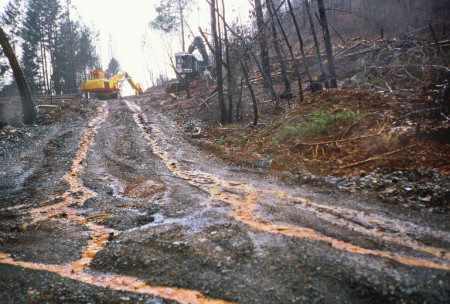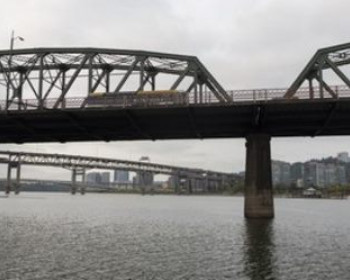Q & A: Decker v. NEDC
Q & A with Mark Riskedahl
Remind us again what was at issue in the case.
In Decker, et al., v. Northwest Environmental Defense Center, —S.Ct.—, 2013 WL 1131708, the U.S. Supreme Court took a look at whether the Clean Water Act and implementing regulations required NPDES permits for the discharge of polluted stormwater from logging roads. NEDC has done a lot of NPDES permit work over the years, and it always struck us as unfair and contrary to law that permits were not required for the timber industry. Along with our tireless partners at the Washington Forest Law Center and Crag Law Center, we decided to push the envelope and see if we could change that.

We’d seen the impressive pollution-reduction results achieved in a wide range of other industrial and municipal contexts, and felt that NPDES permits could be an important new regulatory tool to drive the reduction of sediment and other pollutant discharges off roads where active timber haul was taking place. These industrial practices often take place up in the upper reaches of watersheds where clean, clear water is important to salmon and a broad range of other aquatic species. Since agencies hadn’t been requiring the timber industry to get permits, if we won, then permits would be required but if we lost, the status quo (no permit required) would remain in place.
How did it make you feel when you learned the Supreme Court granted review of the case?
It was a dark and stormy night- at least it sure suddenly felt like that. It was actually a beautiful sunny morning last summer when we got the news. There are rare moments in life when you are abruptly faced with jarring information that is completely and utterly discordant with the expectations that underlie and comprise a normal day. That was definitely one of those moments.
The probability that the U.S. Supreme Court would take interest in our little case dealing with logging road pollution felt so remote, utterly impossible. Healthcare, marriage equality, voting rights, electronic surveillance: these are the pressing issues of national import that rightly find their way up to the Supreme Court. Sure, logging road pollution mattered to us, but to the highest court in the land?
We immediately started searching for deeper underlying patterns or currents that would provide insight into why the Court granted review. Was this just another strong pro-environment decision out of the Ninth Circuit Court of Appeals that the Supreme Court was looking to overturn, or was there more to it than that?
What was your primary focus once you learned of the Supreme Court’s interest in your case?
Legal representation. We had the utmost faith in the awesome team of attorneys that had been working on the case for years, but we were immediately faced with the question of whether bringing in an experienced Supreme Court practitioner made sense.
There were a lot of people who served as integral resources for us during this early decision-making stage. The prospect of arguing a case before the Supreme Court presents itself so rarely that suddenly some of the most prominent and well-respected legal thinkers in the country are answering your calls. Personal opinions by lawyers and Supreme Court watchers were informative, but ultimately, it came down to a question of probabilities. Empirical reviews by Professor Richard Lazarus and others comparing the track record of experienced vs. first time Supreme Court lawyers led us to the conclusion that we’d be best off bringing in an experienced Supreme Court litigator to serve as Counsel of Record in our case.
Of course, the fact that the other side petitioned the Court for review and then obtained review meant that the deck was firmly stacked against us. From the start, the odds were that we were going to lose. As a result, engineering a relatively painless loss or “soft landing” without collateral damage to the Clean Water Act and citizen suit litigation was paramount. In retrospect, we feel we achieved that.
Looking back on how things played out, we couldn’t be happier with our decision to bring on Jeff Fisher at Stanford’s Supreme Court Litigation Clinic. Jeff had previously argued more than a dozen cases before the Supreme Court, is an incredibly sharp and engaging advocate, and did an awesome job for us. It was great to have a fresh set of eyes on the case. Plus, our long-standing legal team performed exceptionally well in partnership with him.
Similarly, there were numerous compelling amicus briefs submitted by parties in support of our efforts. We can’t thank the authors of those briefs enough; they did an incredible job.
What, in summary, did the Supreme Court decide?
We lost on the merits: polluted discharge off logging roads does not require an NPDES permit. The other side also raised two important jurisdictional arguments, but lost them both.
First, they claimed that although our case was framed as a citizen suit targeting specific polluters, what we were really trying to do was to attack an EPA rule that had been on the books for decades and we shouldn’t be allowed to do that. The Court disagreed with them. It held that since the rule at issue was ambiguous and NEDC only urged the Court to adopt a purposeful but permissible reading of the regulation to bring it into harmony with the statute, we were not seeking to invalidate the rule. Our victory on this point has been viewed by some observers as expanding the reach of the Clean Water Act’s citizen suit provision.
Second, in an interesting eleventh-hour development late on the Friday afternoon immediately preceding oral argument the following Monday morning, EPA published a final rule expressly exempting logging road pollution discharges from NPDES permitting. This last minute rule clearly irked the Justices. It was intriguing: why would EPA swoop in at the last minute to finalize a rule that exempts a category of discharges the agency claimed were already exempt under its old rule? The discharges were exempt before. Now they were, what- super, double extra exempt? The other side, emboldened by this last-minute rule-making effort, claimed our case was now moot.
A ruling by the Supreme Court against us on this point would have sent a disturbing message to agencies that if a rule (even an exceptionally vague rule) is ever challenged, the agency can step in during litigation and “fix” it after the fact. Thankfully, the Court held that EPA’s rule revision did not moot our case and a live, justiciable controversy existed over our alleged violations of the pre-amendment rule.
The Court’s 7-1 decision ultimately revolved around the question of how much deference an agency should be given when it writes rules interpreting a statute. Permits would have been required if the pollutant discharges off logging roads were “associated with industrial activity.” EPA said logging is not industrial. Finding that the terms “industry” and “industrial” have multiple definitions that may not necessarily encompass timber harvest activities, the majority rejected our contention that “associated with industrial activity” unambiguously covers discharges of channeled stormwater runoff from logging roads.
Justice Scalia, interestingly enough, was totally on the same page as us and stated in his dissenting opinion, simply: “Enough is enough.” The majority, he wrote, wrongly “gives effect to a reading of EPA’s regulations that is not the most natural one, simply because EPA says that it believes the unnatural reading is right.” Instead, he argued, “the fairest reading of the agency’s rules proscribes the conduct at issue.”
Justice Scalia?
Yep. We’ve been toying with the idea of making him an honorary member of NEDC. During the brief writing, at certain points our legal team was targeting him directly. Federal environmental laws contain incredibly protective language, and there is significant upside to seeing that language construed strictly and conservatively. It was clear to us that the plain language of the Clean Water Act and EPA’s rule interpreting the statute were on our side, and he agreed with us. Unfortunately, his colleagues weren’t quite willing to come along.
“[T]here is some interest in reconsidering” the Court’s jurisprudence on agency deference, wrote Chief Justice Roberts in a concurring opinion in our case, signaling that the red carpet has been rolled out for future deference challenges. It will be fascinating to watch upcoming cases in which advocates have the opportunity to more fully brief and argue over the proper scope of agency deference.
More Northwest Environmental Defense Center (NEDC) Stories
Northwest Environmental Defense Center is located in Law School.
MSC: 51
email nedc@lclark.edu
voice 503-768-6726
fax 503-768-6671
Jonah Sanford
Executive Director
jonah@nedc.org
Eve Goldman
Law Clerk
nedc@lclark.edu

